The Whole Enchilada Part III: The Tortillas
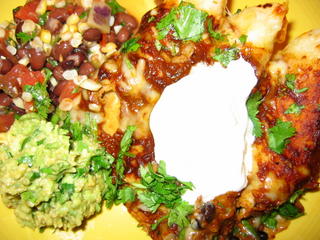 The soul of the enchiladas isn’t the sauce, nor is it the filling.
The soul of the enchiladas isn’t the sauce, nor is it the filling.
It is the simple, humble tortilla.
Which is why I don’t make enchiladas with store-bought tortillas anymore. To put it bluntly, they suck. They taste like soggy cardboard and have a mealy texture. There is nothing about them that evokes the flavor or aroma of corn.
And corn is the essence of tortillas.
So, I make them fresh. At the moment, I do it with pre-ground masa that can be bought in five pound bags in Latin American markets; I do have some dried corn and slaked lime to use to make them really from scratch, following the directions put forth by Diana Kennedy. (I appreciate her a great deal; she is a woman after my own heart–dedicated to the point of obsessive when it comes to matters culinary.) I am just lacking a corn grinder; my Sumeet -can- grind the corn, but in the amounts needed for masa dough, I suspect it would be tedious to use the Multi-Grind to do the job. So, I am scouting around for a corn grinder of some sort in order to take up full-scale tortilla making. (After the corn grinder, my next step is to find a farmer to grow the proper kind of corn for me, so I can have locally made tortillas. At that point–who knows–maybe I wil start a tortilla factory.)
 The first time I made tortillas from scratch, I was surprised at two things. One, at how simple the process really was, and two, how -good- the tortillas tasted. They smelled like freshly parched corn–if you have ever smelled that–or stoneground cornmeal fresh from the hopper. They were heavenly to eat, too—the corn flavor comes through the highly seasoned sauce, the cheese and meat and really gives a structure not only to the enchiladas themselves, but to the layered flavors.
The first time I made tortillas from scratch, I was surprised at two things. One, at how simple the process really was, and two, how -good- the tortillas tasted. They smelled like freshly parched corn–if you have ever smelled that–or stoneground cornmeal fresh from the hopper. They were heavenly to eat, too—the corn flavor comes through the highly seasoned sauce, the cheese and meat and really gives a structure not only to the enchiladas themselves, but to the layered flavors.
But making them–it was utterly foolproof. They are made with two ingredients: masa flour and water. You follow the directions on the package (I use Maseca brand) and add 1 1/8 cups of water to 2 cups of masa, and then knead it into a smooth dough by hand. You know it is ready when it takes on the texture and pliability of Play-Doh. Yes, Play-Doh. (That was my favorite toy as a kid–I was always “baking” things with it. Are we surprised? No, I suspect not.)
At that point, it is time to divide the dough into sixteen equal balls.
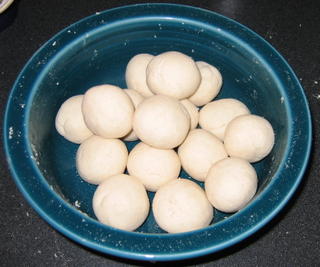 I do this by rolling into one ball and then cutting it into quarters. These I roll into balls and cut in half, which gives me eighths. Each eighth, I roll into a ball and cut in half, and voila! Sixteenths, which I roll into equal sized, smooth balls, pile back into the mixing bowl and cover with a damp towel while I start pressing and cooking the tortillas.
I do this by rolling into one ball and then cutting it into quarters. These I roll into balls and cut in half, which gives me eighths. Each eighth, I roll into a ball and cut in half, and voila! Sixteenths, which I roll into equal sized, smooth balls, pile back into the mixing bowl and cover with a damp towel while I start pressing and cooking the tortillas.
Now, we need to talk about tortilla presses.
I know that there are a lot of very practiced abuelas out in the world who eschew tortilla presses and pat the masa out by hand into beautiful, flat, thin cakes. Well, I am not one of them. I am a gringa who didn’t grow up eating real, live corn tortillas and watching my mamma pat them out by hand, so I have no clue. Hell, I went to culinary school and can’t toss pizza dough without endangering the ceiling, so patting tortillas by hand is not going to happen.
And if you are anything like me, and I bet that you are, you need a tortilla press.
You can get cheap aluminum ones anywhere it seems, and my first one was one of those.
I ended up hating the damned thing, and gave it away to the Salvation Army. Who knows what someone picked it up to use it for, but there we are.
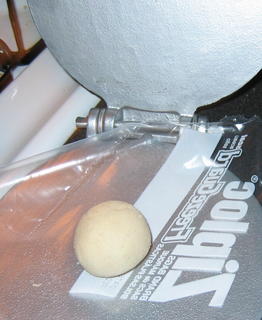 The kind of tortilla press you need is a cast iron one that is nice and heavy. They are made in Mexico and you have to use very little pressure to make nice thin tortillas. You can get them in various sizes, and they aren’t very expensive, and from what I can tell, they will last until the world ends, so if you get one, expect to pass it down to your great-grandchildren. I bought mine here.
The kind of tortilla press you need is a cast iron one that is nice and heavy. They are made in Mexico and you have to use very little pressure to make nice thin tortillas. You can get them in various sizes, and they aren’t very expensive, and from what I can tell, they will last until the world ends, so if you get one, expect to pass it down to your great-grandchildren. I bought mine here.
To use the tortilla press, you want to line both the top and the bottom with plastic. Some folks use plastic wrap, but I sacrificed a nice heavy Ziploc bag by cutting it apart and have used that for months now. You just wipe it clean with a damp cloth and put it away with the tortilla press. The plastic keeps the tortillas from sticking to the press and making a godawful mess.
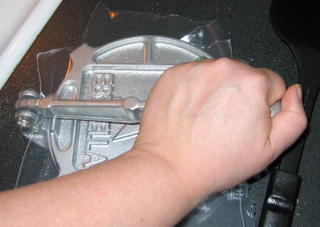 What you do is just put one piece of plastic on the bottom, put the ball of dough slightly off-center on the press, flatten it slightly with your palm, place the other piece of plastic over it, and then close the press. Bring the lever down with mild pressure, then lift up, and voila!
What you do is just put one piece of plastic on the bottom, put the ball of dough slightly off-center on the press, flatten it slightly with your palm, place the other piece of plastic over it, and then close the press. Bring the lever down with mild pressure, then lift up, and voila!
You have a tortilla.
Pick it up with the sheets of plastic, and peel off the top sheet, then the bottom sheet, and flip it into your preheated cast iron pan.
Ah, the pan.
You can use a traditional flat Mexican griddle called a comal, but you don’t have to. I just use the well-seasoned lid to a deep cast iron skillet, turned upside down. (This particular piece is meant to be used as griddle anyway.)
Just remember not to grease your cooking surface in any way, and get it nice and hot before you lay a tortilla down on it.
 I use high heat and cook it for about forty-five seconds to a minute on the first side, then flip it once, and cook it about the same on the other side. When you flip it, there should be some browned freckles on the cooked side, as shown at left.
I use high heat and cook it for about forty-five seconds to a minute on the first side, then flip it once, and cook it about the same on the other side. When you flip it, there should be some browned freckles on the cooked side, as shown at left.
Unlike leavened pancakes, tortillas don’t really give you any visible sign that they are getting cooked, except they smell like nice toasty corn. But there are no bubbles, no sizzling, nothing. They just bake silently and stealthily on the smooth cast iron, which means the first ones you make, you will flip them more than once, maybe more than twice, until you get a feel for how long they need to cook.
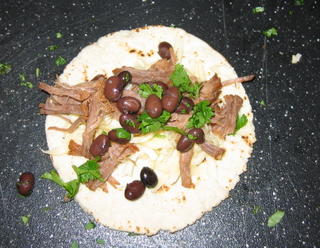 I have found that if I am cooking alone, that if I take a tortilla out of the press, and lay it on the hot pan, I have enough time to lay the plastic down, put out another masa ball and play with the upper sheet of plastic and press it, before I need to flip the cooking tortilla. After I flip it, I open the press, peel the plastic away, then scoop up the first tortilla and lay down the second one into the its place on the hot iron.
I have found that if I am cooking alone, that if I take a tortilla out of the press, and lay it on the hot pan, I have enough time to lay the plastic down, put out another masa ball and play with the upper sheet of plastic and press it, before I need to flip the cooking tortilla. After I flip it, I open the press, peel the plastic away, then scoop up the first tortilla and lay down the second one into the its place on the hot iron.
If I am cooking by myself, I usually put the tortillas into one of those big heavy plastic tortilla keepers to keep them nice, warm and pliable.
However, if you are working with a second person, you can toss the cooked tortillas directly on a work surface, and they can fill and shape them, then lay them in a pan to await the drizzle of sauce and sprinkle of cheese.
I always put cheese -in- my enchiladas as well as on them, along with whatever shredded meat I have, some black or pinto beans, and lots of cilantro. Sometimes I add strips of fire roasted bell or poblano peppers as well, particularly if I am making vegetarian enchiladas.
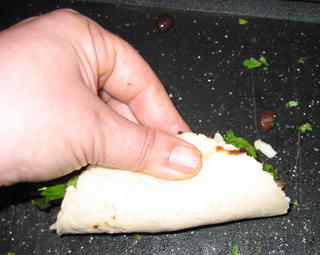 Then, I fold them up into half-moon or taco shapes, rather than roll them. Unless I am in a mood for stacked enchiladas–then I layer sauce on the bottom of the pan, then tortillas to cover it, then cheese, fillings and sauce and tortillas, sauce, fillings, cheese and tortillas, then sauce and cheese. It is kind of a Mexican casserole thing–sort of a New World lasagne.
Then, I fold them up into half-moon or taco shapes, rather than roll them. Unless I am in a mood for stacked enchiladas–then I layer sauce on the bottom of the pan, then tortillas to cover it, then cheese, fillings and sauce and tortillas, sauce, fillings, cheese and tortillas, then sauce and cheese. It is kind of a Mexican casserole thing–sort of a New World lasagne.
Whether I fold or stack them, I always spray my baking pan with some canola oil spray and then spread a couple of tablespoons of sauce in the bottom to keep the enchiladas from drying out or sticking. Then, I layer them in whatever fashion until the pan is full, then ladle sauce over them in strips. I don’t completely inundate them with sauce; I generally leave some edges of the tortillas out in the open to brown and get nice and crispy for a textural contrast. Then, I sprinkle cheese over and bake them–and when they come out of the oven, a bit of roughly chopped cilantro goes over it all.
Ingredients:
32 freshly made corn tortillas
1 pound of shredded cheese, preferably a mixture of queso blanco and sharp cheddar
1 pound of shredded meat filling
2 cups or so of sauce (verde or Colorado)
1-2 cups of cooked black or pinto beans or strips of fire roasted sweet or poblano peppers, or grilled corn cut from the cob, or caramelized onions or sauteed bitter greens such as kale or collards (or all of the above)
1 cup roughly chopped fresh cilantro
1 cup sliced scallions (optional)
canola oil spray or canola oil
Method:
Preheat oven to 375 degrees.
Spray three 9″X9″ glass baking pans with canola oil and spread the bottom with a couple of tablespoons of sauce.
Lay a tortilla flat on work surface, and sprinkle with a tablespoon or so of cheese, then the fillings of your choice. I like to make certain to include some fresh cilantro and/or some scallion slices in the filling.
Fold the tortilla into a half-moon shape over the filling, and lay half-upright in the baking dish. Continue with all other tortillas, fitting about ten or eleven or so enchiladas per pan. When they are all fitted in, pour a ladleful of sauce down each row of tortillas and top with more shredded cheese.
Bake for 20-30 minutes, or until cheese is melted and bubbly and the sauce is molten, and the exposed bits of tortilla are crispy. As soon as you remove them from the oven, sprinkle with more cilantro and/or scallions, to allow the garnish to wilt slightly.
Garnish with fresh salsa, guacamole and sour cream, if you wish.
9 Comments
RSS feed for comments on this post.
Sorry, the comment form is closed at this time.
Powered by WordPress. Graphics by Zak Kramer.
Design update by Daniel Trout.
Entries and comments feeds.




See if you can lay your hands on the “proper” corn. During Bunyan we can get a small batch ground I think. If not, we can get fresh ground. See, I have these freinds….
I can tell you more Saturday around 7:30ish in the PM. We are good to go and the Fishes are up for it as well.
No gosa pizza for us! WOO HOO!!!
Xai Xai, Mei Mei and see you then!
Comment by Bryian — August 30, 2005 #
I’ve totally enjoyed this series–I’m fanatic about Mexican food!
Fresh tortillas are amazing. Did your tortillas “puff”? I’ve taken a lot of Mexican cooking classes including a week long one in Oaxaca with Susan Trilling. In Mexican cooking lore it’s said that a tortilla is ready when it puffs because then you know someone loves you! I’ve also given up on metal ones. The one to get is a homemade one that they sell here in SF that’s made of light pine or some such wood. Let me know if you want to buy one!
Comment by Jeanne — August 30, 2005 #
Nihao, Bry! Yes, we will see you at seven thirty on Saturday!
And if we can get some corn ground–well, that will be excellent. I have the corn, and the cal–all I need is someone with a stone grinder to grind it. Maybe your friend could do some for us and we can have fresh tortillas–and tamales!
Welcome, Jeanne! Yes, my tortillas puff up! I forgot to talk about that. But I am going to do a Diana Kennedy recipe that requires the puffing up business so you can stuff the tortilla with a filling–so I will talk about it then.
I adore Mexican food, too. Zak doesn’t love it as much as I do–his first love is still Chinese (as is mine), but Mexican food gets to me. I love all the ways they cook chiles and all the sauces. Lovely.
Comment by Barbara Fisher — August 30, 2005 #
Thank you for this series which I am so enjoying reading. Good Mexican food not only satisfies hunger but feeds the soul. I took classes several years ago from a wonderful lady (4th generation San Diegan) by the name of Elena Cota. From her I found a beautiful wood press that pats out my tortillas to perfection. I love your idea of using a cut up baggie and will try that next time. In addition I found an electric tortilla maker that allows me to cook the tortillas at the table so everyone gets a fresh hot one. I pass around the “stuffings” and they serve themselves with which delights tickle their fancy for that tortilla.
Comment by Anonymous — August 30, 2005 #
what a beautiful dish.
Comment by sarah — August 31, 2005 #
I can never decide if I prefer Chinese, Mexican, or Indian food. Italian is in there too. If I had one that I had to chose just one to live with for the rest of my life, though, I’d probably pick Chinese, (and I’d probably live a lot longer!)
Anyway…
Heather and I made Enchiladas recently, using a good amount of your recipe, though we used Pace enchilada sauce that we SERIOUSLY doctored up, (cause you have to,) and store bought tortillas which we knew would be, as you said, cardboard-like and bland, so Heather decided to experiment and use some flatbread, which I think was some that she brought back from Lebanon.
It came out well. Good experiment, and next time, we’ll make our own enchilada sauce.
Tortillas will have to wait for a while, though the electric tortilla maker sounds quite cool! 😉
-Dan
Comment by Dan — August 31, 2005 #
Thank you, Anon and Sarah–
I agree that good Mexican food feeds the soul as well as the body, but then, I tend to believe that all good peasant foods of the world feed the soul as well as the body.
I will stretch and say that all food, prepared with love, whether it is haute cuisine or hillbilly cookin’, feeds every human hunger, both the physical bodily hungers and the soul hunger for connection and affection.
Dan–
I cannot choose a single beloved cuisine, either, which is why I cook so many different dishes from different places. I think I just like strongly flavored foods, period, end of story.
The use of flatbread sounds like a good choice! Thanks for the tip.
The electric tortilla makers are not bad things, but I think it is just as easy to use the press and the pan. And if you use the dried masa mix, making the dough isn’t so bad, either.
If you all ever want lessons, you know where you can come!
Comment by Barbara Fisher — September 1, 2005 #
I will definately try this recipe. We have discovered a little shop in the city which sells freshly made small corn tortillas, they’re amazing in comparison to the prepacked things you can get at the supermarket
Comment by Pamela — April 8, 2006 #
LOVE TO BUY A WOOD TORTILLA PRESS.CAN ANYONE TELL ME WHERE TO BUY FROM? THANKS
Comment by LYNN — June 26, 2009 #